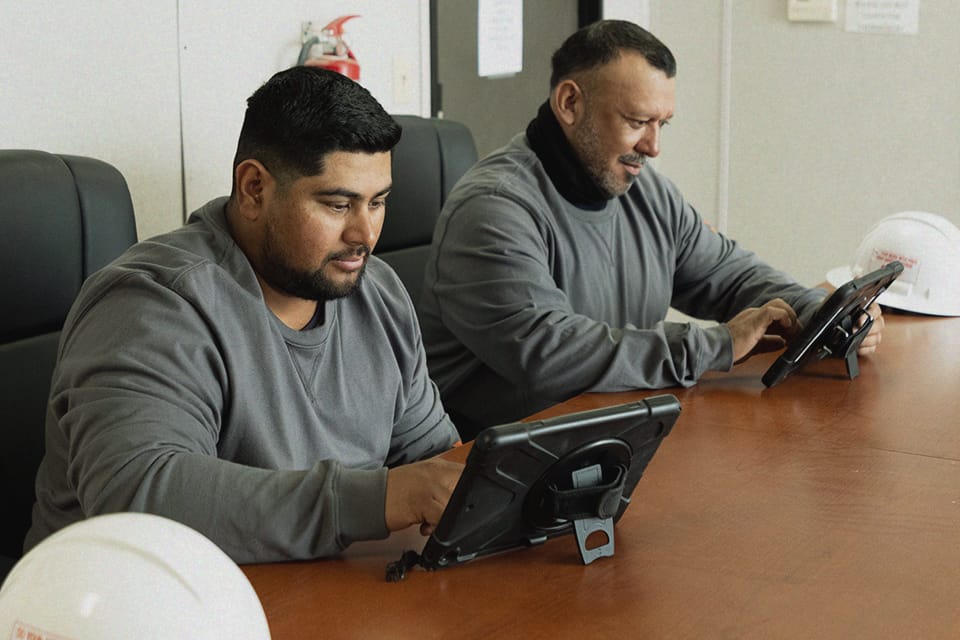
OSHA Logs Are Due: Don’t Make These 5 Costly Mistakes | Risk Matrix Episode 123
THE RISK MATRIX Cutting-edge podcast on occupational safety and risk management. Hosted by industry titans: JAMES JUNKIN, MS, CSP, MSP,…

Health and safety training is essential for keeping a safe workplace, empowering teams, and safeguarding their well-being. However, providing those teams with a lackluster training program can result in severe consequences, such as accidents, injuries, and lawsuits. These incidents can potentially cripple a business, and in many cases, there’s no way to recover.
But here’s the good news: It doesn’t have to be that way.
Requiring the best industry training fosters a work environment where emergencies are met with calm action, not panicked confusion. In addition, teams learn to recognize and avoid hazards before they become problems.
To help organizations understand these concepts better, this article outlines how to go about building a training program and lists specific classes all companies should consider for their workers.
Health and safety training is essential for workers in high-hazard industries. The proper instruction can mean the difference between a safe work site and one riddled with potential hazards.
However, choosing the right classes for your training program requires thought and preparation, which might include the following three steps:
The first step in building a solid safety program is understanding all the standards and regulations applicable to your industry. These guidelines aren’t just bureaucratic red tape—they’re crafted from years of research and practical experience to keep workplaces safe.
Knowing the rules is just step one. To really keep your workers safe, you need to stay ahead of any potential hazards specific to your worksite. This is where experience and attention to detail really come into play, and safety professionals should never assume anything is safe just because it meets the minimum legal requirements.
It’s crucial to thoroughly assess every aspect of the work environment, from equipment and processes to hazard communication and emergency preparedness. Once you understand your company’s specific hazards, it’s time to create training programs that tackle those risks head-on.
The next step is to partner with experienced trainers who understand your team’s needs and provide the necessary training materials relevant to your team, including daily tasks and challenges. This way, management can address common issues and unique hazards while helping workers build crucial safety skills.
This program should start with thorough safety orientations and regular refresher courses. Ongoing training creates an atmosphere where everyone involved is encouraged to talk openly about safety. It also drives home the point that safety cultures require steady commitment – not something to be checked off as done after one session.
Adhering to a top-notch safety program is no small feat, but it’s definitely worth the effort. Knowing you’ve done everything to prepare your team for potential hazards helps you sleep better at night.
Depending on your specific industry, some classes will be more relevant than others. However, classes that might be relevant to most workers include the following:
A basic safety orientation class equips new workers with the essential knowledge and awareness they need to navigate worksite challenges safely. By taking part in one of these courses, workers gain a comprehensive understanding of workplace safety protocols, from proper personal protective equipment (PPE) usage to emergency response procedures.
Working in confined spaces like tanks, vessels, and pipelines can be tricky and dangerous. That’s why anyone who might need to work there should absolutely get confined space entry training.
A solid training program will teach you everything from recognizing confined space hazards to using proper safety equipment and procedures for safe entry. It’s not simply ticking off requirements; it’s empowering workers with crucial knowledge to handle challenging environments safely.
Core compliance training helps build a confident and safety-conscious workforce. It’s designed to engage employees actively and foster a deep understanding of essential safety practices. Teams will be empowered to recognize and avoid hazards and confidently implement best practices to prevent injuries and illnesses.
This training also ensures employees meet the necessary pre-qualification requirements while laying the groundwork for a culture of safety that protects your employees and keeps your business running smoothly.
Working in the oil and gas field means dealing with hazardous substances like hydrogen sulfide. Exposure to this highly toxic gas can lead to severe health issues or death if concentrations are too high.
Hydrogen sulfide is dangerous stuff; proper safety training for those exposed is crucial. Workers should learn about H2S properties, detection methods, and emergency procedures because these skills are lifesaving.
Lockout/Tagout (LOTO) training offers a comprehensive solution for ensuring safety during equipment maintenance. By following a systematic approach to controlling hazardous energy sources, LOTO procedures significantly reduce the risk of accidents, injuries, and even fatalities that can occur from unexpected equipment energization.
LOTO training empowers workers by equipping them to find the distinct types of hazardous energy they might encounter during maintenance tasks. The training also dives into carefully selecting and applying lockout devices, minimizing the risk of accidents caused by unintentional equipment activation.
NORM/TENORM training is all about staying safe around naturally radioactive stuff (NORM) and things that become radioactive after getting a helping hand from humans (TENORM). These materials pop up in all sorts of industries, from oil rigs to mines and even water treatment plants.
This training gives you the lowdown on how to spot NORM/TENORM in your workplace, what kind of health risks it might pose, and most importantly, how to stay out of harm’s way. By learning these safety steps, you can seriously cut your chances of getting exposed to radiation and keep yourself healthy for the long haul.
Pipeline safety training equips workers with the ability to confidently handle these crucial components. It dives into key areas like spotting hazards, dodging risks, and even handling emergencies.
By recognizing dangers, following safety protocols, and knowing what to do in a pinch, these newly trained pipeline operators keep the vital systems running smoothly and, most importantly, safely.
Exposure to hazardous particles like dust or harmful chemicals such as fumes and gases remains a critical problem in many sectors. Ensuring lung protection means getting it right every time without fail.
This is where learning about respiratory protection steps in. The best classes will show workers how to pick out the right gear and take care of it properly. While it might seem dull compared to other topics, it’s vital for those who face air pollutants on the job.
Driving might seem like a routine activity, but motor vehicle accidents are one of the top causes of work-related injuries and deaths.
This is why having thorough motor vehicle safety training matters a lot. Employees must recognize road hazards and know how to handle them through careful driving, routine maintenance of their vehicles, and staying prepared for any unexpected situations.
To gauge the training program’s effectiveness, teams might consider using various methods like post-training tests and competency exams or watching how employees perform their tasks. Managers should also check incident reports and look for clear signs that the training has made things safer and reduced mishaps.
You should also encourage onsite workers to provide regular feedback. Team leaders should ask them what parts of the training they found most useful, where they had difficulties, and what topics they’d like to see revisited.
As mentioned earlier, it is also important to remember that training is not a one-and-done deal. As any company evolves and new hazards emerge, the safety training program also needs to adapt. Companies should prioritize regularly reviewing and updating their courses to ensure they are still relevant and effective.
Crafting a safety training program that meets your company’s exact needs takes effort and commitment. However, this approach makes a significant difference in safeguarding employees. A well-tailored and engaging training session becomes more than mandatory; it’s crucial for fostering a strong safety culture.
Digital records are an effective way to keep track of safety training completion. Cloud storage makes it easy to verify if workers have finished their courses and eliminates the hassle of digging through files for certificates.
However, what about on-site verification? When workers need to prove their qualifications at the moment, a digital record alone might not be enough. That’s where printed photo ID cards come in.
These cards provide a tangible, universally recognized form of proof that your workers have completed the necessary training. Instant proof that a worker is qualified for the job streamlines the verification process and speeds up their access to the site, helping everyone get to work faster.
Offering quality training shows your team you genuinely care about their well-being. It equips them with the skills and knowledge to stay safe on the job, creating a safer environment for everyone involved.
However, the true value of that investment depends on the health and safety training classes you choose. To guarantee that teams receive the most comprehensive training, your program should include many of those discussed above.
Allow Veriforce and our network of certified instructors to empower your workers with the know-how to complete their jobs as safely as possible.
Contact us for more information.


THE RISK MATRIX Cutting-edge podcast on occupational safety and risk management. Hosted by industry titans: JAMES JUNKIN, MS, CSP, MSP,…

THE RISK MATRIX Cutting-edge podcast on occupational safety and risk management. Hosted by industry titans: JAMES JUNKIN, MS, CSP, MSP,…
We’ll send you practical and insightful supply chain risk management info that can benefit your business. Plus, important company updates that keep you in the loop.
